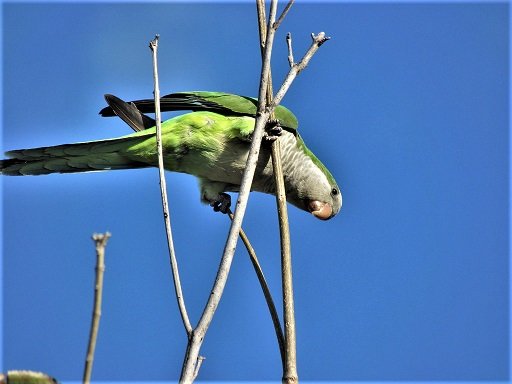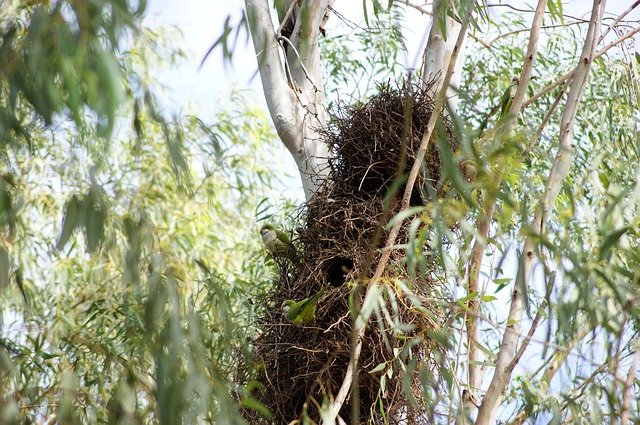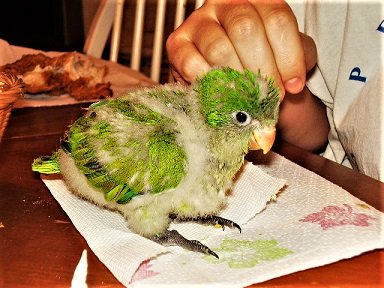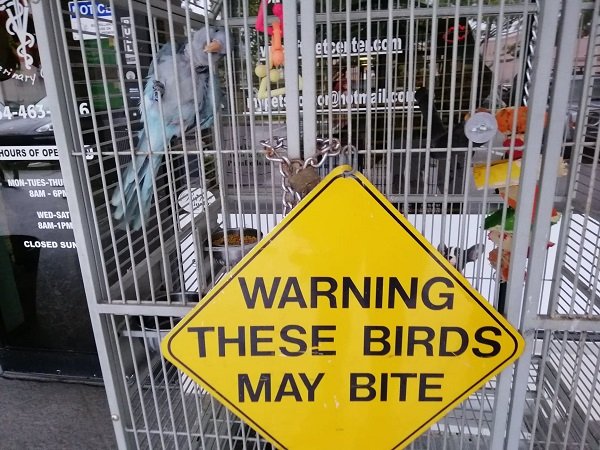Parrots are among those birds who don’t build nests at all. They prefer to live in hollowed-out trees or even grounds. But of the 393 parrot species of parakeets, there is one which loves to make nests from scratch and they are our very own Quaker parrots.
They have an inborn desire to have their ‘home’. And when this attitude of constructing their nest is backed by their natural ability of precision, i.e., gripping things strongly with their one pair of feet and cutting them with perfection with the other pair, their inner architect takes the charge. A long-lasting structure is then built where future generations live and keep on adding more rooms as their population grows.

Quakers: The Colony Nesters
Quakers are the official ‘Colony Nesters’ of the parrot species and when we talk about their nests, we aren’t referring to any ordinary nests. Quakers make these giant nests which are often quite huge and elaborate for their whole flock. The average weight of these nests can be 100 pounds, some even weighing up to 200 pounds.
Since they prefer to live with their colonies only, these nests are then slowly occupied by another fellow Quakers. The nests are so strong that they can withstand strong winds blowing at 60 miles an hour.
Quakers are very social birds and this applies to their nesting habits also. They are very communal while making nests. Living with their flock provides them a sense of security. The nests built from twigs are known to be quite huge as these can accommodate even more than 40 birds. Their nests are usually the size of a compact car and at times, squirrels and other small mammals are seen living inside them with these friendly little birds.
Nest Making In The Wild
When parrots are in the wild, they don’t make nests. Just like most of the birds, they live in the hollowed-out trees or branches, rock formations and even live in burrows for breeding and then the flock shifts as the season changes. But our Quakers are unique. They make suite-like structures and put the architect inside them to the best use.

Building nests and their maintenance is a family business. The young Quakers learn it early on from their parents. The young ones get expert at collecting nest material like twigs, grass, paper or other natural material; cutting them neatly of a particular size and finally weaving them intricately into the nests. The quicker they learn, the better.
When in the wild, Quakers often construct their nests on cliff sides or trees’ canopies. When they are living in the cities, their favorite locations are the ones that can give them warmth in winters and can withstand the weight of their humongous home-like rooftops, lighting poles, power lines, floodlights, utility poles, and even the air conditioning systems. They choose a location where they can easily get food and water supply for their survival.

The Quaker nests are dome-like arrangements of sticks which are often called ‘Quaker Apartments’ or ‘Quaker Condominiums’ for their sheer resemblance to the apartments we live in. Although the nests at first are only ‘Starter Nest’, as only one pair lives, slowly it turns into a ‘Colony Nest’ after the young ones are born and the other flock members join in, by adding their apartment to that structure.

Each unit in these apartments or ‘condos’ as they are generally called, is occupied by a mated Quaker pair. Each unit is divided into three parts; the bedroom, the living area, and the entrance. The bedroom is used for mating, laying eggs and hatching them. The young ones stay there for a month and are then shifted to the living area which is where they live now, as the bedroom is required for mating again. The entrance area is used by the Quaker couple to enter or leave the nest or to take flights. It is also an important area to keep an eye on any predator hovering around the nest.
More about Quaker Parrot Breeding:
https://parrotsinfo.net/quaker-parrot-breeding/
The urge to build their dream house is at its peak in spring or late summer season which is the apt season to start the family for them as Quakers are known to prefer rainy season for mating. The Quaker female lays 4 to 8 eggs at one time. The eggs hatch in 24 days and the survival rate is roughly 50%. The Quaker parents have often helping hands from neighbor beings to raise their offspring. A Quaker then again prefers to start re-touching their nests.

These awe-inspiring nests have always been a subject of curiosity for Quaker lovers and there have been many hotspots in America only where these little birds’ fascinating homes can be spotted. Brooklyn, Austin, Texas, Chicago, Dallas, New Jersey, Connecticut, Massachusetts are few of the places where their nests can be seen in city parks.
Take a look at the video of Quaker parrot building nest in Freeport on Electricity pole:
Even in Europe, their nests are not uncommon to spot in city parks of Madrid, Barcelona, Athens, Brussels, France, Italy, and many more. Not only this, due to their population increasing at a fast rate, but their nests are also a regular sight in countries like Canada, Brazil, Mexico, Australia, and Israel.
Nest Making Inside The Cage
Quakers have a very unusual desire of making their home even if provided one. They not only possess the intelligence to make their beautiful condominium but also the strong determination to have it at any cost, no matter whether they are in the wild or inside a cage at their ‘home’. Even if these cages aren’t big enough to house a nest inside, a Quaker won’t give up trying. Your Quaker will pick anything around the house which can pass the cage bars and will help him weave through them. Millet sprigs, shredded paper, vines, ribbons, shoelaces, pens, pencils are their favorites.

Seeing the immense joy it gives them, many owners provide essential nest making material to their little birds. Pine shavings, toothpicks, popsicle sticks, ropes, small branches, little sticks, and even kitchen skewers. Keep them all near your Quakers’ cage and leave the rest to the weaver inside them.
More about essentials inside birds cage:
https://parrotsinfo.net/bird-cage-supplies/
Breeding box for Quaker parrot in our Amazon Store
Quaker Parrot nest material
If you choose to provide your Quaker Parrot with the nest material, it is important to ensure that harmful or toxic stuff is kept away from them. Cut the sharp edges of things like kitchen skewers. Oak shavings shouldn’t be given as they are toxic. The twigs shouldn’t be sprayed with pesticides or fertilizers or any such chemical. Avoid giving them fabric that can get stuck in their feet. Cut ropes or such material into smaller sizes of 4 to 6 inches so that they don’t get entangled. Wash the branches taken from the wild with water or mild bleach to remove the germs.
Quakers also have a great civic sense just like us humans. Just the way we guard our privacy and don’t like peeping, they also don’t like to be disturbed or more so, their privacy being compromised. They will run after you or even bite you if you will try reaching or looking inside. Also, keep your other pets like dogs or cats away from their private space as they will chase them till they are taught a lesson. There had been instances where Quaker owners have complained of being attacked by their otherwise gentle Quaker when they tried to look inside their nests. So, be careful!
Quaker parrot pair
Most of the owners adopt Quakers in pairs. This gives these little birds a sense of companionship which is the very essence of their being. And when it comes to making a nest as a team, Quakers may behave either way. There may be fights between them over the perfect location or their preferred material. Or there may not be any fight but only a team effort. One such instance of a pair of Quaker making a nest by using clothespins and arranging them in a pattern has fascinated bird lovers. The talented duo, Sparky and Alexandra, lives in Portland, Oregon used their owners’ bookshelf and turned it into a masterpiece (2). Sparky has been a star parrot, known all over the world for making largest nests and he never stops.
Conclusion
Practically, a Quaker owner can’t be with their Quaker at home all the time. A sense of fear always hover in the minds of those owners who are deeply bonded with their Quakers, like ‘he might accidentally hurt himself in an attempt to keep himself entertained’ ; ‘I have kept his cage in the window so he can see the passers-by and not get bored, I hope no cat pass by the lane’ ; or more so, the worst thought ‘My birdie is slipping slowly into depression due to loneliness, I should start taking some time off from work but that is not a permanent solution’. So, it gives us a sense of relief thinking that they have an engaging work behind our backs.
Letting Quakers make nests inside their cages will keep your parrot’s curious mind busy. It will channelize his energy in what he loves. This will also keep his mind and body quite active. Doing what he loves will also keep this little bird happy which, in turn, keeps the Quaker parent happy.

